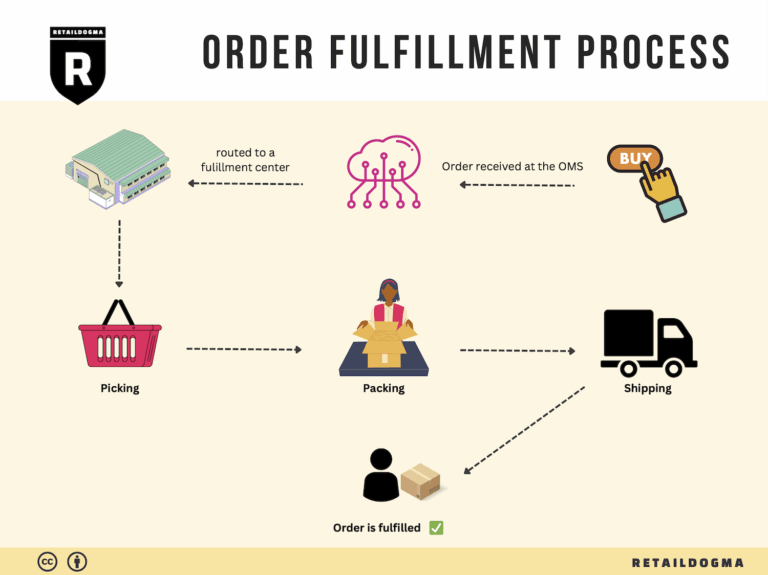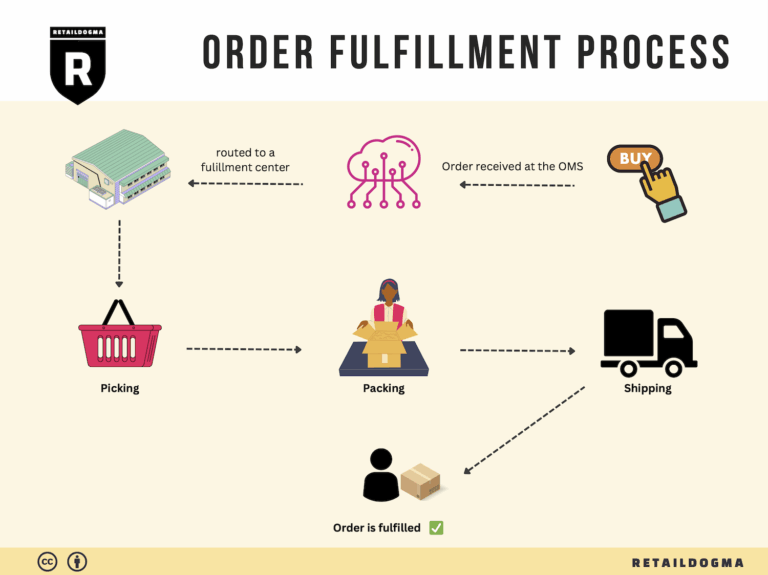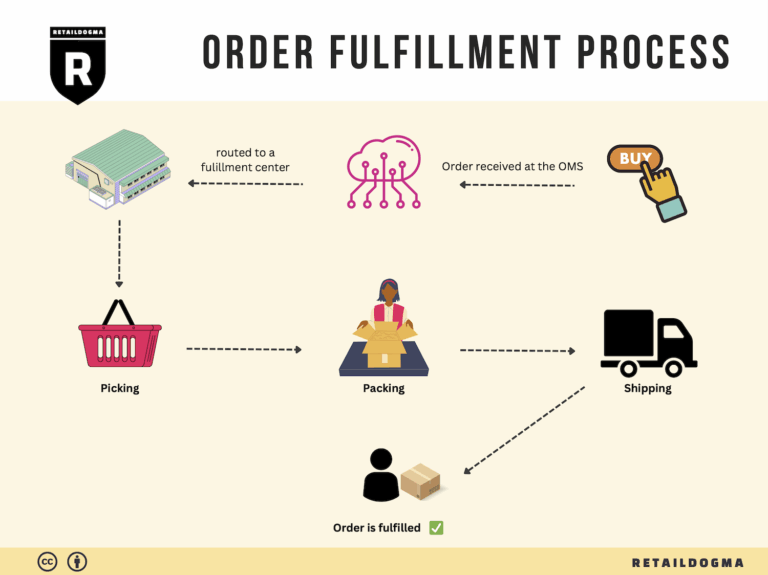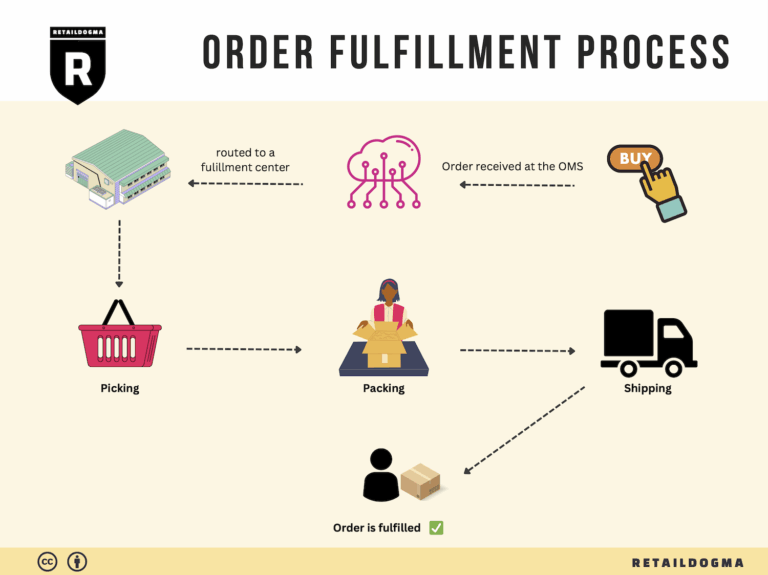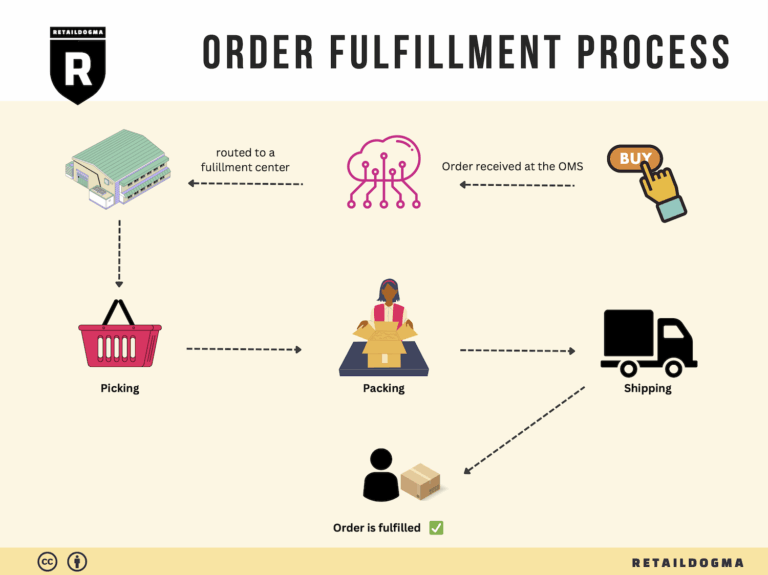How Order Fulfillment Works: A Step-by-Step Guide for Businesses
What is E-commerce Fulfillment? An Introduction for Growing Businesses
As your online business begins to thrive, the excitement of growing sales can quickly turn into the daunting task of managing packing and shipping orders. For many entrepreneurs, the thrill of e-commerce can be overshadowed by the logistical complexities that come with fulfilling customer orders. This is where understanding e-commerce fulfillment becomes crucial.
E-commerce fulfillment is simply the process of getting a product from your inventory to your customer’s doorstep. It encompasses everything from receiving and storing inventory, processing orders, picking and packing items, to shipping them out. For growing businesses, navigating this landscape can be overwhelming, especially when trying to maintain the high standards of customer service that foster loyalty and repeat purchases.
This guide aims to demystify the world of e-commerce fulfillment by exploring various models and core services that can help streamline your operations. We’ll delve into popular fulfillment models such as Third-Party Logistics (3PL) and Fulfillment by Amazon (FBA), both of which offer different advantages depending on your business needs. Understanding the nuances of these options can help you determine which model aligns best with your operational goals and customer expectations.
Additionally, we will cover the essential services involved in fulfillment, including inventory management, order processing, packing, and shipping. Each of these components plays a pivotal role in ensuring that your customers receive their orders in a timely and efficient manner.
Choosing the right fulfillment partner is another critical aspect that this guide will address. We will provide insights into what to look for in a partner, including their technology capabilities, reliability, and scalability, ensuring you can grow without being hindered by logistical challenges.
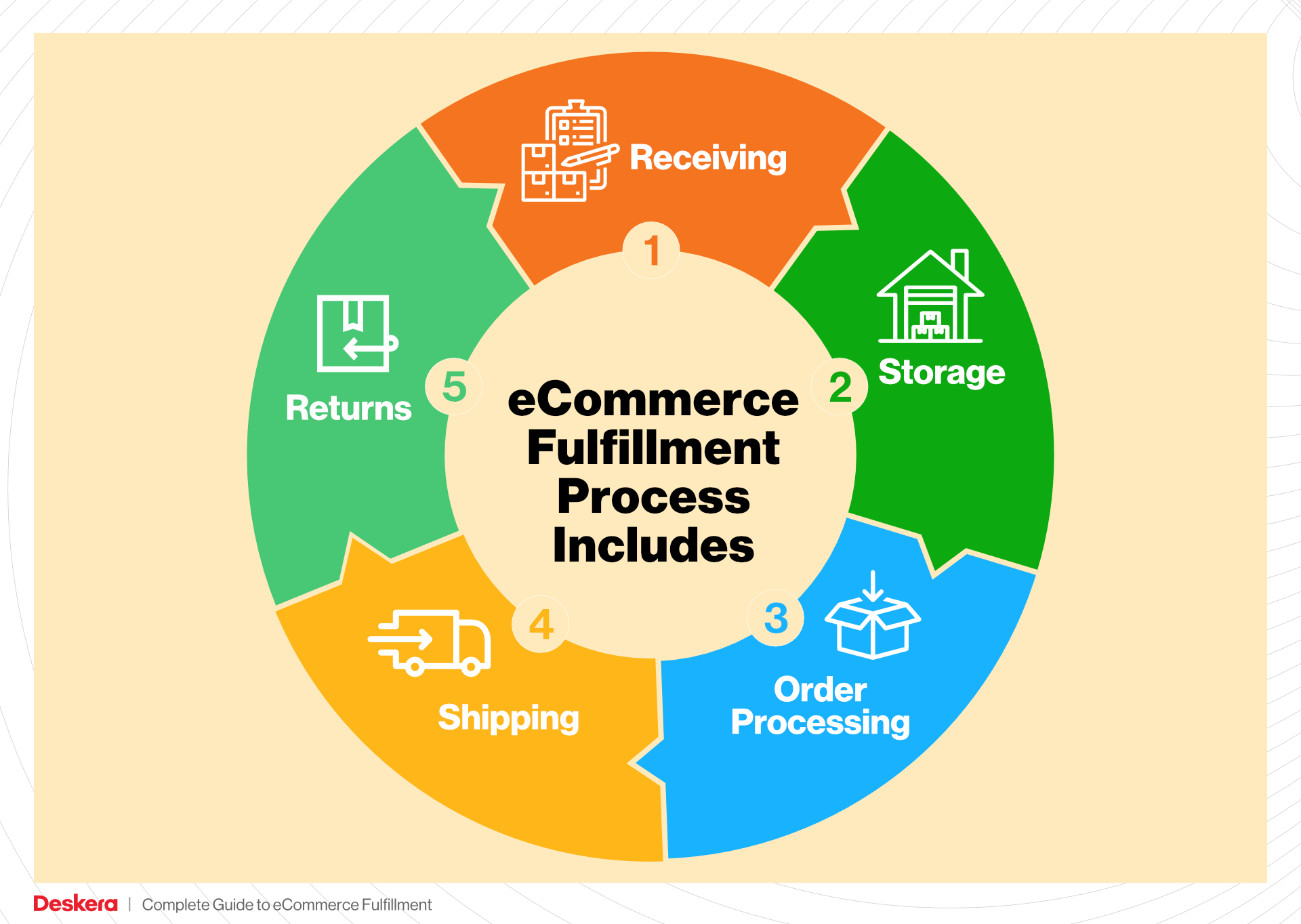
Pricing is often a significant concern for growing businesses, so we will also explore various pricing structures and what factors can influence costs in the fulfillment process.
Ultimately, this guide aims to empower you with the knowledge to make informed decisions about your logistics strategy. By understanding the intricacies of e-commerce fulfillment, you can focus on scaling your business while ensuring that your customers receive the exceptional service they deserve.
What You’ll Learn In This Guide
- What is E-commerce Fulfillment? An Introduction for Growing Businesses
- The Order Fulfillment Process: From ‘Buy’ Button to Customer’s Door
- Comparing Fulfillment Models: In-House vs. 3PL vs. Dropshipping
- A Deep Dive into Amazon FBA: Pros, Cons, and Who It’s For
- Core Services Offered by Fulfillment Centers
- How to Choose a Fulfillment Partner: A 6-Point Checklist
- Understanding Fulfillment Pricing: A Breakdown of Common Fees
- Frequently Asked Questions (FAQs) about Fulfillment
- Conclusion: Is Outsourcing Fulfillment the Right Move for Your Business?
- Important Disclaimer
The Order Fulfillment Process: From ‘Buy’ Button to Customer’s Door
1. Receiving Inventory
The first step in the order fulfillment process is receiving inventory. This is where products are delivered to the fulfillment center and checked against the purchase order. Upon arrival, items are inspected for damage, and quantities are verified to ensure that what was ordered matches what has been received. This step is crucial because discrepancies can lead to stockouts, increased costs, and delays in fulfilling customer orders.
A key term associated with this step is SKU (Stock Keeping Unit). Each product is assigned a unique SKU, which helps in tracking inventory levels, managing stock efficiently, and ensuring that the correct items are stored and shipped. By maintaining an organized receiving process, businesses can better manage their inventory and minimize errors.
2. Warehouse Storage
Once the inventory is received and verified, it is then placed in designated storage locations within the warehouse. This stage involves organizing products in a way that maximizes space and optimizes accessibility. Efficient warehouse storage is vital because it directly impacts how quickly orders can be picked and packed.
A common practice in this phase is to utilize ABC analysis, which categorizes inventory based on its importance and sales frequency. High-demand items (A) are stored closer to the packing area, while less frequently sold items (C) may be placed further away. Proper storage solutions not only improve order fulfillment speed but also help in managing inventory levels and reducing holding costs.
3. Order Picking
Order picking is the process of selecting items from the warehouse to fulfill customer orders. Once a customer places an order, the fulfillment team generates a pick list that details the items and quantities needed. This step is critical because it is where the actual products are gathered for shipping, and any errors can lead to incorrect orders being sent out.
There are several picking methods, including single order picking, batch picking, and zone picking. Each method has its advantages depending on the scale and structure of the warehouse. For instance, batch picking allows multiple orders to be picked simultaneously, improving efficiency. Effective order picking not only accelerates the fulfillment process but also enhances customer satisfaction by ensuring accuracy and timeliness.
4. Order Packing
Once the items are picked, they are brought to the packing station, where they are prepared for shipment. This step involves checking the items again for accuracy and quality, then packing them securely to prevent damage during transit. Proper packing is essential because it protects the products and ensures they arrive in good condition, which is critical for maintaining customer trust.
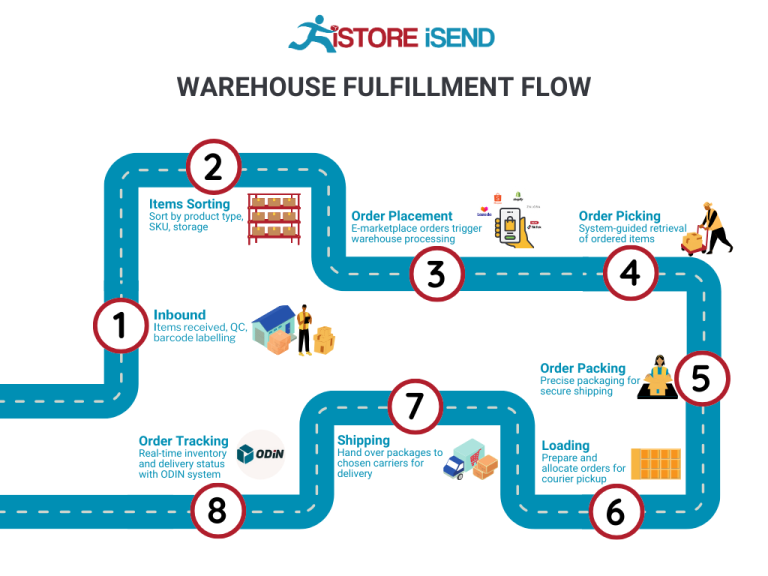
A key aspect of this phase is packing slips, which are included with each order to provide customers with details about their purchase. Additionally, businesses may use automated packing systems to streamline the process, reduce labor costs, and minimize human error. Efficient packing not only speeds up the fulfillment process but also enhances the overall customer experience.
5. Shipping & Delivery
The final step in the order fulfillment process is shipping and delivery. Once the orders are packed, they are labeled and handed over to shipping carriers for delivery to the customers. This stage is vital because it directly influences delivery times and customer satisfaction.
In this phase, businesses must choose reliable shipping partners and may offer various shipping options, such as standard, expedited, or same-day delivery. Key terms associated with this step include tracking numbers, which allow customers to monitor their orders in real-time. Providing accurate tracking information enhances transparency and builds trust with customers.
Efficient shipping and delivery are crucial for maintaining a competitive edge in e-commerce. Businesses that prioritize fast and reliable shipping can improve their customer retention rates and encourage repeat purchases, ultimately driving growth in sales and brand loyalty.
By mastering each of these five steps—receiving inventory, warehouse storage, order picking, order packing, and shipping & delivery—e-commerce businesses can streamline their order fulfillment processes, reduce costs, and enhance the overall customer experience.
Comparing Fulfillment Models: In-House vs. 3PL vs. Dropshipping
Fulfillment Model Comparison
| Model | Who Handles Inventory | Best For (Business Stage) | Key Advantage | Key Disadvantage |
|---|---|---|---|---|
| In-House Fulfillment | The business itself | Established businesses | Full control over inventory and processes | Higher overhead costs and complexity |
| Third-Party Logistics (3PL) | External logistics provider | Growing businesses | Scalability and reduced operational burden | Less control over inventory management |
| Dropshipping | Supplier | Startups and small businesses | Low upfront investment and risk | Lower profit margins and reliance on suppliers |
In-House Fulfillment
In-house fulfillment refers to a model where the business manages its own inventory and order processing. This approach is typically adopted by established businesses that have the resources and infrastructure to handle logistics internally. One of the primary advantages of in-house fulfillment is the level of control it affords the business. Companies can oversee inventory levels, quality control, and order accuracy without relying on an external partner. This control can lead to improved customer service, as businesses can respond more swiftly to issues and tailor the fulfillment process to their specific needs.
However, in-house fulfillment comes with significant overhead costs, including warehousing, staffing, and technology investments. These costs can become a burden, especially for businesses that experience fluctuations in demand. Additionally, managing fulfillment in-house can introduce complexities, such as the need to implement efficient inventory management systems and ensure compliance with shipping regulations. As businesses scale, they may find that the in-house model strains their resources, prompting them to explore other fulfillment options.
Third-Party Logistics (3PL)
Third-party logistics (3PL) involves outsourcing logistics and supply chain functions to a specialized provider. This model is ideal for growing businesses that need to scale their operations without the burden of managing logistics themselves. By leveraging a 3PL provider, companies can benefit from the provider’s expertise, technology, and infrastructure, allowing them to focus on core business activities like marketing and product development.
One of the key advantages of 3PL is scalability. As a business grows, its logistics needs can change rapidly, and a 3PL provider can adapt to these changes, offering flexible solutions to meet evolving demands. Additionally, using a 3PL can lead to cost savings, as businesses can reduce overhead associated with warehousing and logistics. However, relying on a third-party provider also means that businesses have less control over inventory management and fulfillment processes. Any issues that arise in the logistics chain can impact customer satisfaction, making it crucial to choose a reliable 3PL partner.
Dropshipping
Dropshipping is a fulfillment model where a retailer does not keep products in stock but instead transfers customer orders and shipment details directly to a supplier or manufacturer, who then ships the products directly to the customer. This model is particularly appealing for startups and small businesses looking to minimize risk and reduce upfront investment. Since there is no need to purchase inventory upfront, businesses can test different products and markets without significant financial commitment.
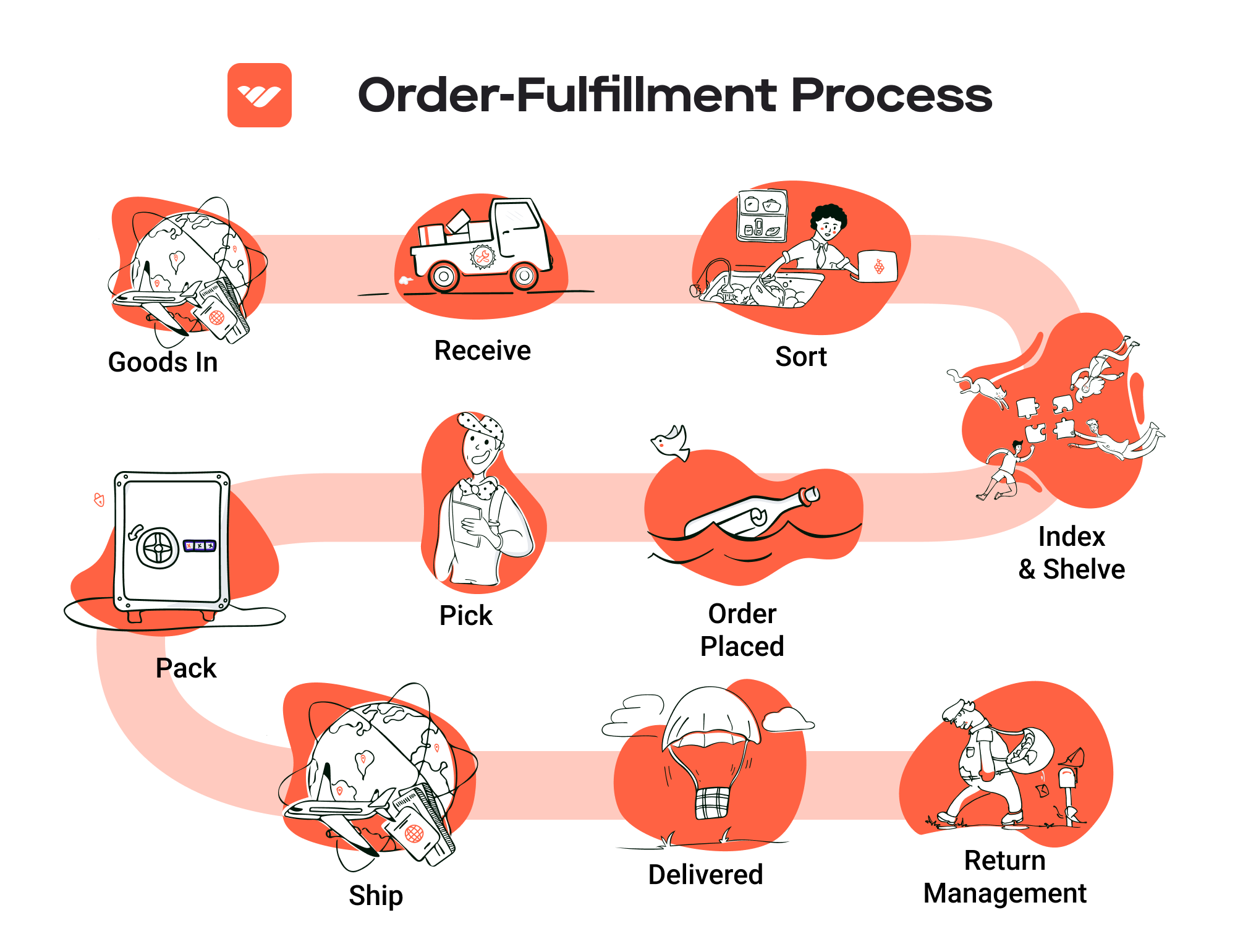
The primary advantage of dropshipping is the low barrier to entry. Entrepreneurs can start an e-commerce business with minimal capital and avoid the complexities of inventory management. However, dropshipping also comes with its challenges. Profit margins tend to be lower compared to other fulfillment models, as businesses often have to pay wholesale prices to suppliers while selling at retail prices. Furthermore, reliance on suppliers for inventory and shipping can lead to issues with product availability and shipping delays, which can negatively affect customer satisfaction. As a result, businesses must carefully select trustworthy suppliers to mitigate these risks.
Conclusion
Each fulfillment model presents unique advantages and challenges, and the choice between in-house fulfillment, 3PL, and dropshipping largely depends on the specific needs and stage of a business. Established companies may benefit from the control and customization offered by in-house fulfillment, while growing businesses might find the scalability of 3PL more suitable. On the other hand, startups can take advantage of the low-risk nature of dropshipping to enter the market. Ultimately, understanding these models will empower e-commerce business owners to make informed decisions that align with their operational goals and growth strategies.
A Deep Dive into Amazon FBA: Pros, Cons, and Who It’s For
Understanding Fulfillment by Amazon (FBA)
Fulfillment by Amazon (FBA) is a service offered by Amazon that allows sellers to store their products in Amazon’s fulfillment centers. Amazon takes care of storage, packaging, and shipping, as well as customer service and returns. This service can be a game-changer for e-commerce businesses looking to scale their operations while leveraging Amazon’s vast logistics network and customer base.
How FBA Works
-
Product Listing: Sellers create product listings on Amazon and choose to enroll in the FBA program. They can either send their products directly to Amazon’s fulfillment centers or have them stored elsewhere and ship to Amazon as orders come in.
-
Storage: Once the products are received at Amazon’s warehouses, they are stored until they are sold. Sellers are charged storage fees based on the volume of space their products occupy.
-
Order Fulfillment: When a customer places an order, Amazon picks, packs, and ships the product on behalf of the seller. This process is streamlined and often takes advantage of Amazon’s advanced logistics technology, ensuring rapid delivery.
-
Customer Service: Amazon handles all customer service inquiries related to FBA orders, including returns and refunds, allowing sellers to focus on other aspects of their business.
-
Multi-Channel Fulfillment: Sellers can also utilize FBA for orders placed on other platforms, such as their own e-commerce websites, giving them flexibility in how they manage their sales channels.
Pros of Using FBA
-
Prime Eligibility: Products fulfilled by Amazon are automatically eligible for Amazon Prime, which can significantly increase sales. Prime members are more likely to purchase items that offer fast, free shipping, and this can enhance the visibility of your products.
-
Customer Trust: Selling through Amazon and using FBA can enhance your brand’s credibility. Customers often trust Amazon’s handling of transactions, which can lead to higher conversion rates.
-
Multi-Channel Fulfillment: FBA allows sellers to fulfill orders from multiple sales channels, not just Amazon. This flexibility can help streamline operations and maintain consistent customer service across platforms.
-
Scalability: FBA allows businesses to scale without needing to invest heavily in warehousing and logistics. As sales grow, sellers can easily send more inventory to Amazon without worrying about storage space.
-
Time Savings: By outsourcing logistics to Amazon, sellers can focus on other important aspects of their business, such as product development, marketing, and customer engagement.
Cons of Using FBA
-
High Fees: While FBA can save time and effort, it comes at a cost. Sellers must pay for storage fees, fulfillment fees, and additional charges for long-term storage or if their products are oversized. These fees can quickly add up, especially for businesses with tight margins.
-
Strict Inventory Rules: Amazon has stringent inventory management policies. Sellers must keep track of their stock levels and ensure they don’t run out of inventory, as this can affect their seller ranking and visibility. Additionally, unsold inventory can incur long-term storage fees.
-
Commingling Risks: When sellers use FBA, their inventory may be commingled with that of other sellers. This can lead to concerns about product quality and authenticity, as sellers cannot control the handling of their products once they are in Amazon’s warehouses.
-
Limited Control Over Branding: While FBA provides access to Amazon’s customer base, it also means that sellers have limited control over their branding and customer interactions. Products are often shipped in Amazon-branded packaging, which may dilute brand identity.
-
Dependence on Amazon: Relying on FBA means that sellers are subject to Amazon’s rules and policies, which can change without notice. This dependence can pose risks, especially if Amazon alters its fee structure or fulfillment processes.
Who is FBA Best For?
Fulfillment by Amazon is an excellent option for various types of businesses, particularly those looking to scale rapidly without the complexities of managing logistics. Here are some ideal candidates for FBA:
-
New Sellers: Entrepreneurs just starting in e-commerce can benefit from FBA’s infrastructure and customer trust, allowing them to focus on growing their business rather than managing fulfillment.
-
Small to Medium-Sized Businesses: Companies that lack the resources to manage their own warehousing and shipping logistics can leverage FBA to streamline operations and reduce overhead costs.
-
Brands Looking for Expansion: Established brands aiming to reach a broader audience can use FBA to tap into Amazon’s extensive customer base and increase their sales without significant investments in logistics.
-
Seasonal Sellers: Businesses that experience seasonal spikes in demand can benefit from FBA by scaling their inventory during peak times without the long-term commitment of a warehouse lease.
In conclusion, Fulfillment by Amazon presents both opportunities and challenges for e-commerce businesses. Understanding the intricacies of FBA can help sellers make informed decisions about whether this fulfillment model aligns with their operational goals and business strategies.
Core Services Offered by Fulfillment Centers
Inventory Management & Warehousing
Fulfillment centers offer comprehensive inventory management and warehousing services, crucial for e-commerce businesses that need to maintain efficient operations. This service encompasses the storage, tracking, and management of products, ensuring that stock levels are optimal and that businesses can meet customer demand without overstocking or running into shortages.
The benefits of effective inventory management are significant. First, it minimizes the costs associated with excess inventory, such as storage fees and obsolescence. By utilizing advanced inventory tracking systems, fulfillment centers can provide real-time data on stock levels, helping businesses make informed decisions about purchasing and sales strategies. Moreover, a well-organized warehouse enhances order accuracy and speed, resulting in improved customer satisfaction. When products are stored logically and tracked efficiently, the likelihood of errors during order fulfillment decreases, leading to fewer returns and a stronger brand reputation.
Pick and Pack Services
Pick and pack services are at the heart of the fulfillment process. This service involves selecting items from inventory (picking) and then packaging them for shipment (packing). Fulfillment centers utilize skilled staff and automated systems to ensure that orders are processed quickly and accurately.
The advantages of pick and pack services are manifold. For one, they streamline the order fulfillment process, allowing e-commerce businesses to handle larger order volumes without sacrificing speed or accuracy. This is particularly important during peak seasons when demand can spike unexpectedly. Additionally, fulfillment centers often offer customized packing solutions, which can enhance branding and improve the unboxing experience for customers. By ensuring that products are securely packed and presented well, businesses can foster customer loyalty and encourage repeat purchases.
Kitting and Assembly
Kitting and assembly are specialized services that involve grouping multiple items together into a single package or preparing items for sale. This can include assembling products that require multiple components or bundling related products for promotional purposes. Fulfillment centers are equipped to handle these complex tasks efficiently, often utilizing skilled labor and specialized equipment.
The primary benefit of kitting and assembly services is the ability to offer customers unique product combinations that can drive sales. For instance, a tech retailer might bundle a laptop with accessories such as a mouse and a case, creating a compelling offer that enhances perceived value. This not only simplifies the purchasing process for customers but also can lead to higher average order values. Furthermore, by outsourcing these tasks to fulfillment centers, e-commerce businesses can focus on their core competencies, such as marketing and product development, while ensuring that their products are prepared correctly for the market.
Returns Management (Reverse Logistics)
Returns management, also known as reverse logistics, is a critical service offered by fulfillment centers that handles the process of returning products. This includes receiving returned items, inspecting their condition, restocking them if they are sellable, and managing the overall return process.
The significance of effective returns management cannot be overstated. In the e-commerce space, where customers expect hassle-free returns, having a streamlined process can significantly enhance customer satisfaction and loyalty. Efficient returns management reduces the time and resources spent on processing returns, allowing businesses to recover valuable inventory quickly. Additionally, fulfillment centers can analyze return data to identify trends, helping businesses understand customer behavior and improve product offerings or descriptions to reduce future returns. By making the returns process as seamless as possible, companies can turn a potential negative experience into a positive one, fostering trust and encouraging customers to shop again.
Conclusion
In conclusion, fulfillment centers provide a suite of core services that are essential for e-commerce businesses aiming to scale their operations efficiently. From inventory management and warehousing to pick and pack services, kitting and assembly, and returns management, these services not only streamline logistics but also enhance customer satisfaction and brand loyalty. By leveraging the expertise and infrastructure of fulfillment centers, e-commerce businesses can focus on growth and innovation, leaving the complexities of logistics in capable hands. As the digital marketplace continues to evolve, partnering with a reliable fulfillment center can be a strategic move for businesses looking to thrive in a competitive landscape.
How to Choose a Fulfillment Partner: A 6-Point Checklist
Location & Warehouse Network
Importance:
The geographical location of a fulfillment partner’s warehouses directly impacts shipping times, costs, and overall customer satisfaction. A partner with warehouses strategically located near your customer base can significantly reduce transit times and shipping expenses.
Questions to Ask:
– Where are your warehouses located, and how do they align with my target market?
– What is your average shipping time for different regions?
– How many warehouses do you operate, and what is their capacity?
Technology & Integrations
Importance:
In today’s digital landscape, having a robust technology infrastructure is crucial for seamless operations. A fulfillment partner should offer advanced technology solutions that integrate with your e-commerce platform, inventory management systems, and order processing tools to streamline operations.
Questions to Ask:
– What technology platforms do you use for order management, inventory tracking, and reporting?
– Can your systems integrate with my existing e-commerce platform (e.g., Shopify, Magento)?
– What kind of real-time data can I expect access to regarding inventory levels and order status?
Specializations (e.g., cold storage, oversized items)
Importance:
Different products require different handling and storage methods. If your business involves specialized items—such as perishables requiring cold storage or oversized items—it’s critical to choose a fulfillment partner with relevant expertise and facilities.
Questions to Ask:
– Do you have experience handling my specific product types?
– What special equipment or conditions do you offer for items that require temperature control or unique storage solutions?
– How do you manage inventory for specialized items to ensure quality and compliance with regulations?
Scalability & Capacity
Importance:
As your business grows, your fulfillment needs will likely evolve. A good fulfillment partner should have the capacity to scale operations without compromising service quality. This includes having the ability to handle seasonal spikes in demand.
Questions to Ask:
– How do you manage fluctuations in order volume?
– What is your current capacity for handling orders, and how quickly can you scale up operations if needed?
– Can you provide examples of how you’ve supported clients during peak seasons or rapid growth phases?
Pricing and Contracts
Importance:
Understanding the pricing structure and contract terms of a fulfillment partner is essential to ensure it aligns with your budget and financial goals. Transparent pricing can help you avoid unexpected costs that can arise from hidden fees.
Questions to Ask:
– What is your pricing structure, and what factors influence costs (e.g., storage fees, order processing fees, shipping costs)?
– Are there any hidden fees I should be aware of, such as for returns or special handling?
– What are the terms of your contract? Is there flexibility if my needs change?
Customer Support & Reviews
Importance:
Reliable customer support is crucial for resolving issues quickly and maintaining smooth operations. Additionally, reviews and testimonials from other clients can provide insights into the fulfillment partner’s reliability and service quality.
Questions to Ask:
– What customer support options do you offer (e.g., phone, email, live chat), and what are your response times?
– Can you provide references or case studies from businesses similar to mine?
– How do you handle service disruptions or issues with orders, and what is your process for communication during such events?
Conclusion
Choosing the right fulfillment partner is a pivotal decision for any e-commerce business. This checklist provides a structured approach to evaluating potential partners based on key factors that influence your operational efficiency, customer satisfaction, and overall success. By asking the right questions and conducting thorough research, you can ensure that you select a fulfillment partner that aligns with your business goals and supports your growth trajectory.
Understanding Fulfillment Pricing: A Breakdown of Common Fees
Initial Setup Fees
When partnering with a fulfillment center, the first cost you may encounter is the initial setup fee. This fee typically covers the costs associated with establishing your account, integrating your e-commerce platform with the fulfillment center’s system, and configuring inventory management tools. The setup process might also include the creation of custom packaging options and branding materials.
Setup fees can vary significantly depending on the complexity of your needs. For example, if you require advanced software integration or multiple sales channel connections, expect to pay more. On average, initial setup fees range from $200 to $1,000. To ensure you are not overpaying, always ask for a detailed breakdown of what the fee covers and if any recurring charges will be incurred.
Receiving Fees
Once your products arrive at the fulfillment center, receiving fees come into play. These fees cover the labor and equipment required to unload, inspect, and inventory your merchandise. Receiving fees are typically calculated based on the number of pallets or boxes received.
For instance, a fulfillment center might charge $25 to $50 per pallet or $5 to $10 per box. The complexity of your inventory can also affect these fees; items requiring special handling or inspection may incur additional costs. To keep these fees manageable, ensure that your shipments are organized and clearly labeled, which can streamline the receiving process.
Storage Fees (per pallet/bin)
Storage fees are ongoing costs incurred while your products are stored in the fulfillment center. These fees are usually charged monthly and can be calculated per pallet or per bin, depending on how your inventory is organized.
The average storage fee can range from $10 to $50 per pallet per month or $2 to $10 per bin. Factors influencing these costs include the size and weight of your products, as well as the length of time they remain in storage. To minimize storage fees, maintain optimal inventory levels and consider implementing a just-in-time inventory strategy, which can help reduce excess stock.
Pick & Pack Fees (per item/order)
Pick and pack fees are charged for the labor involved in retrieving items from storage and preparing them for shipment. These fees are typically calculated on a per-item or per-order basis, depending on the fulfillment center’s pricing model.
For example, a center might charge $1 to $5 per item picked, and additional fees may apply for packing materials such as boxes or bubble wrap. If your orders frequently contain multiple items, you may be able to negotiate a bulk rate. To optimize these fees, consider streamlining your product offerings and improving order accuracy to reduce the number of items that need to be picked and packed.
Shipping Fees
Shipping fees are one of the most significant components of fulfillment pricing, as they cover the cost of delivering your products to customers. These fees can vary widely based on several factors, including the shipping method chosen (standard, expedited, or same-day), the size and weight of the package, and the destination.
Fulfillment centers often negotiate shipping rates with carriers and may pass some of these savings on to you, but you should still expect to pay anywhere from $5 to $30 per shipment, depending on the factors mentioned. To reduce shipping costs, consider consolidating orders, using regional carriers, or negotiating shipping discounts based on your volume.
Conclusion and Tips for Accurate Quotes
When seeking fulfillment pricing, it’s crucial to obtain a detailed quote that outlines all potential fees. Here are some tips to ensure accuracy:
-
Request a Comprehensive Breakdown: Ask for a detailed list of all fees, including any additional costs that may arise during peak seasons or promotional events.
-
Evaluate Your Needs: Consider your inventory turnover, order volume, and product characteristics to determine the most appropriate pricing model.
-
Compare Multiple Providers: Don’t settle for the first quote you receive. Comparing multiple fulfillment centers will give you a better understanding of market rates and help identify the best value for your business.
-
Negotiate: Many fulfillment centers are open to negotiation, especially if you can demonstrate a consistent order volume.
By understanding these common fulfillment pricing models and following these tips, you can make informed decisions that enhance your e-commerce operations and ultimately support your business growth.
Frequently Asked Questions (FAQs) about Fulfillment
1. What is a fulfillment center?
A fulfillment center is a specialized facility that handles the storage, packing, and shipping of products for e-commerce businesses. Unlike traditional warehouses, fulfillment centers focus on efficiently processing orders and managing logistics to ensure timely delivery to customers.
2. What’s the difference between a warehouse and a fulfillment center?
While both warehouses and fulfillment centers store products, their primary functions differ. Warehouses are designed mainly for storage and inventory management, whereas fulfillment centers are optimized for order processing, picking, packing, and shipping products directly to customers. Fulfillment centers often utilize advanced technology to streamline operations, enhancing speed and efficiency.
3. What is a 3PL (Third-Party Logistics)?
A Third-Party Logistics provider, or 3PL, is an external company that manages a business’s logistics and supply chain operations. This includes warehousing, order fulfillment, inventory management, and shipping. Partnering with a 3PL can help e-commerce businesses scale operations, reduce costs, and focus on core activities like marketing and sales.
4. How does Lenovo’s fulfillment center operate?
Lenovo’s fulfillment center operates by receiving inventory from manufacturers, storing it, and efficiently processing customer orders. When an order is placed, the fulfillment center picks the items, packs them securely, and ships them directly to the customer. The center utilizes advanced technology for inventory management and tracking to ensure timely delivery and accurate order fulfillment.
5. How much do fulfillment services cost?
The cost of fulfillment services varies based on several factors, including the volume of orders, the types of products, storage space required, and additional services such as packaging and returns management. Typically, fulfillment centers charge a combination of storage fees, pick and pack fees, and shipping costs. It’s essential for businesses to evaluate their specific needs and request quotes from multiple providers to find the best fit.
6. What are the benefits of using a fulfillment center?
Using a fulfillment center offers numerous advantages, including:
– Scalability: Easily adjust to seasonal demand fluctuations without investing in additional infrastructure.
– Cost Efficiency: Reduce overhead costs associated with warehousing and staffing.
– Expertise: Leverage the knowledge and technology of fulfillment specialists to streamline operations.
– Focus on Core Activities: Free up time and resources to concentrate on marketing, product development, and customer service.
7. How can I choose the right fulfillment center for my business?
When selecting a fulfillment center, consider factors such as:
– Location: Proximity to your target market can reduce shipping times and costs.
– Services Offered: Ensure the center can meet your specific needs, including order processing, returns management, and international shipping.
– Technology: Look for facilities that utilize advanced systems for inventory management, tracking, and reporting.
– Reputation and Reviews: Research the provider’s track record and client testimonials to gauge reliability and service quality.
8. How does Lenovo ensure the security of its fulfillment operations?
Lenovo employs multiple security measures to protect its fulfillment operations, including:
– Access Control: Limiting access to the fulfillment center to authorized personnel only.
– Surveillance Systems: Utilizing cameras and monitoring systems to deter theft and ensure safety.
– Data Protection: Implementing secure software and encryption protocols to protect sensitive customer and transaction data.
9. What role does technology play in Lenovo’s fulfillment process?
Technology is integral to Lenovo’s fulfillment process, enhancing efficiency and accuracy. Automated inventory management systems track stock levels in real-time, while advanced shipping software optimizes delivery routes. Additionally, data analytics provide insights into order trends, helping Lenovo to make informed decisions and improve service levels.
10. Can I integrate my e-commerce platform with Lenovo’s fulfillment services?
Yes, Lenovo’s fulfillment services can be integrated with various e-commerce platforms through APIs or third-party integrations. This allows for seamless order processing, inventory management, and tracking, enabling businesses to maintain an efficient workflow while leveraging Lenovo’s fulfillment capabilities.
Conclusion: Is Outsourcing Fulfillment the Right Move for Your Business?
The Strategic Advantage of Outsourcing Fulfillment
Outsourcing fulfillment can be a transformative decision for e-commerce businesses aiming for growth and efficiency. One of the primary benefits is time savings. By delegating the complexities of storage, packing, and shipping to a specialized fulfillment partner, business owners can refocus their efforts on core activities like marketing, product development, and customer engagement. This shift not only enhances operational efficiency but also allows for a more strategic approach to scaling the business.
Moreover, scalability is a significant advantage of utilizing a fulfillment service. As your business grows, so does the demand for logistics management. A dedicated fulfillment partner provides the infrastructure and resources necessary to handle fluctuating order volumes, seasonal peaks, and expanding product lines without the need for substantial investments in warehousing and staffing. This flexibility is crucial for maintaining service quality while seizing market opportunities.
Additionally, working with a fulfillment expert brings specialized knowledge and technology that can enhance your operations. These partners often employ advanced inventory management systems, data analytics, and logistics strategies that improve delivery speed and accuracy. This expertise not only streamlines your supply chain but also enhances customer satisfaction—an essential factor in today’s competitive landscape.
However, the success of outsourcing fulfillment hinges on selecting the right partner. A thorough evaluation of potential fulfillment providers is critical to ensure they align with your business goals and can support your growth trajectory.
To assess if outsourcing fulfillment is the right step for your business, consider conducting an audit of your current shipping process. Identify pain points, inefficiencies, and areas for improvement. This analysis will provide clarity on whether a fulfillment partner could enhance your operations and help you scale effectively. Taking this proactive approach may lead to a significant competitive advantage in the evolving e-commerce landscape.
Important Disclaimer
⚠️ Important Disclaimer
The information in this guide is for educational purposes. Fulfillment services, pricing, and platform features change frequently. Always conduct your own due diligence and consult with providers directly before making business decisions.


